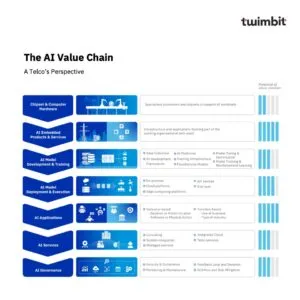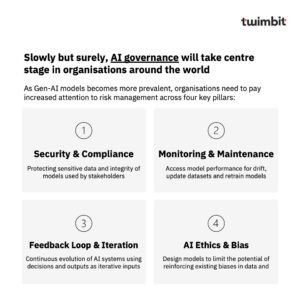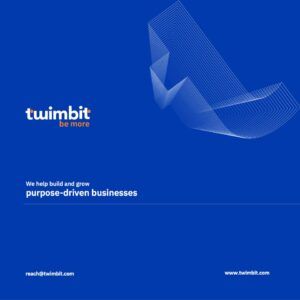Abstract
The attention around artificial intelligence (AI) has exploded, much like the recent hype (and drastic downfall) of the metaverse and Web 3 — with CEOs and senior executives trying to understand whether it’s just another tech hype or a game-changer for their organisation. While the foundational technology isn’t new, the birth of AI applications such as Generative AI (Gen-AI) and other LLM-based tools have sparked new life into this boardroom conversation, especially in telcos.
Yet, most operators have been slow to embrace AI (both in the traditional and modern sense) for internal use cases and their customers. We think a lack of clarity around the AI value chain hinders capital investments in technology, talent, and processes. Here, we provide a comprehensive look at the essentials through an end-to-end framework to help telcos find their footing.
Introduction
Artificial intelligence is the latest technology wave that has crashed the shores of organisations globally, providing a renewed opportunity to reimagine operations and unlock use cases across many industries. The democratisation of access to AI through the launch of ChatGPT, Bard and other content-generation platforms has made promises of zero-touch networks, hyper-personalisation of customer experience and seamless retail experiences — all a reality. The looming ‘Telco to Techco’ story constantly echoing in telco hallways now seems less like a fairytale with artificial intelligence in the picture.
As telcos continue to find new ways to innovate and differentiate under continuous pressure of core commoditisation, a spike in pandemic-related connectivity needs and new-entrant disruptions from digital native competitors, AI could be a new lifeline to spur accelerated industry growth for the decades to come. Several research support this — AI leaders, companies who invest significantly into integrating AI into their organisation and operationalise for value, experience average revenue growth that outpaces peers who lag and greater shareholder returns through share price increase. They also perform better in customer experience and sustainability.
Telcos are in a unique position to make the most out of this technology, given the foundational role they play in modern digital ecosystems, which means capturing C-level priorities either within the organisation or enabling the expansion to a TechCo business model through a state of AI maturity that sees the management of AI capabilities as scalable and reusable products. While becoming an AI-driven company is a long-drawn aspiration, it is certainly within reach of today’s telcos. Operators are starting to recognise that visualising the opportunities through a value chain-oriented lens is non-negotiable for identifying AI investments to scale the business impact generated by the technology as it materialises.
Breaking down the AI Value Chain
Opportunities in AI can be viewed across the value chain from the top level, where hardware is required to support this powerful technology, to the downstream building blocks and platforms to enable its usage at the edge. As opposed to the traditional AI value chain, this adaptation includes the evolution of complex Gen-AI systems, which are increasingly more accessible, lucrative, and meaningful for companies to exploit.
Overall, there are seven high-level pillars — chipset and computer hardware, AI-embedded products & services, AI model development and training, AI deployment and execution, applications, services, and governance. The section below will dive into each category with more detail and examples.
While much of the value chain is dominated by incumbent tech giants and newer AI-focused startups and spin-offs, our research shows early signs of telcos’ footprint exist throughout and is expected to expand to capture emerging value-creation opportunities as early leaders, such as SK Telecom, pave the way for others to follow.
Chipset and Computer Hardware
Computational workloads require the processing of instructions which are designed and created by software components. AI systems work the same way, with the only difference being these systems are made to study patterns and trends in data — lots of it — to acquire intelligence that enables complex algorithms to guide decisions or perform categorisation. However, this large amount of data storage and computing power is too much for traditional computer hardware (e.g., CPUs) to handle.
These types of AI workloads require the development of specialised processors such as graphics processing units (GPUs), tensor processing units (TPUs), field-programmable gate arrays (FPGAs) and custom ASICs that consume massive amounts of electricity, with the necessary logic capabilities, to process billions of parameters simultaneously. This is used in tandem with other physical components in the base level of the AI technology stack, such as a controller node that coordinates and orchestrates other components for memory (DRAM), storage (NAND) and networking (routers, switches).
However, the design and production of specialised processors and chipsets for AI workloads are concentrated due to its heavy capital requirements in the form of startup investments to fund initial R&D and build specialised manufacturing capabilities. Here, NVIDIA, the global supplier of GPUs – who have seen their market cap explode in the face of Gen-AI is accompanied by incumbent hardware manufacturers such as AMD, Google, Intel, IBM, Qualcomm, and Taiwan’s TSMC in dominating the chip design and manufacturing market.
AI Embedded Products & Services
Telcos have long experienced rising valuations for network and infrastructure assets, with the likes of Axiata Group operating an entirely separate business to focus on telecommunications infrastructure and services – shows incredible merit. But generally, telcos operate a more integrated set of structural operations, working with vendors such as Nokia and Cisco across their core, RAN to OSS/BSS and other infrastructure-related portions of the business to offer connectivity to customers. These vendors are tightly intertwined with telcos’ operations, creating a situation where ‘AI value’ can be co-generated if infrastructure-related services and other core solutions are embedded with AI. While not directly part of the AI value chain, telcos can harness its position to capture some internal and external value.
There are two sources of innovation: infrastructure and applications. The first is core infrastructure solutions offered by traditional and emerging vendors such as Ericsson or Mavenir, who infused AI capabilities into their product offerings — Ericsson’s network support services use AI to detect and resolve network anomalies before they impact network performance through a zero-touch approach, offering operators service continuity for 5G use cases and ecosystems.
Similarly, applications that are typically resold and repackaged by telcos in sell-through partnerships with cloud solution vendors have a high potential to be infused with AI and easily distributed to the consumer and enterprise segment, resulting in some form of additional value capture. These SaaS solutions are often bundled with connectivity, billing, and support services. Some that come to mind are workforce productivity suites such as Microsoft 365 — until recently powered by Copilot — that provide AI-based services to customers through a conversational frontend interface to help uncover insights and simplify user operations.
AI Model Development & Training
With foundational processing and compute requirements aptly handled by specialised hardware, the next phase in the AI value chain is developing and training large AI models that often require vast amounts of capital and resources, a journey which only a few companies can truly embark on. The corresponding process involves various steps and stakeholders, each offering specific expertise for development, turning data into a fully functioning model that can be deployed to support a specific or wide range of tasks.
- Data Collection & Annotation
- Data solution providers collect, clean, and annotate datasets for custom AI model training to ensure data is structured in the correct format and AI models learn accurate parameters. This is a manual-heavy process, as labelling and classification are vital in the initial phases. At the same time, there are open-source data sets on the market, specialised in different types of inputs; companies such as Labelbox, Scale AI and Appen provide high-quality training data as commercial offerings for AI applications such as self-driving cars, AR/VR, robotics, etc.
- AI Platforms
- AI Platforms are an integrated set of technologies that enable the development, testing & deployment and refreshment of AI models. This includes centralizing data analysis, designing and streamlining ML production workflows or MLOps, automation of training tasks, customisation, and monitoring AI models in production. Organisations working with AI often leverage top AI platforms such as Google Cloud AI Platform, Microsoft Azure, TensorFlow, Open-Source Machine Learning Platform.
- AI Development Frameworks & Libraries
- Developers, scientists, and researchers tasked to develop and train AI models often start by referring to building blocks to architect, train and validate models and neural networks to prevent starting from scratch. This high-level programming interface are known as AI frameworks, often accompanied by a collection of techniques, tools and pre-built capabilities and components for working with data frames, visualizing data sets and interfaces in a neural network to accelerate model development. Popular examples of such frameworks include TensorFlow, Caffe, Keras and PyTorch.
- Training Infrastructure
- Training an AI model requires heavy computing power, which is only available from specialized hardware such as GPUs and dedicated processing infrastructure, which are expensive and limited due to the recent global semiconductor shortage. This makes most internal model training exercises close to impossible as the cost dynamics make little sense unless for the tech giants sitting on a pile of cash or running a fully stacked technology infrastructure. Other organisations that want to obtain the computational muscle to build and run AI models often look towards hyperscalers or IaaS providers for compute, memory, and storage platforms, as well as direct access to hardware and chips. The leading cloud providers, Microsoft Azure, AWS, and Google Cloud are frontrunners in this department.
- Foundational Models and Customisation
- As Gen-AI enters the fray, foundational models share an equal amount of the spotlight. These are large deep learning models pre-trained on a broad set of unlabeled data that can create a specific type of content or adapted to perform a range of tasks — like a Swiss Army knife — such as producing compelling text, images, and videos, translating text to different languages and generate protein structures or DNA sequences, etc. Foundational models build these capabilities by learning the structure of training data (measured by parameters) to generate new human-like content, compared to previous generations of AI models that were “narrower” and could only perform one task at a time.
There are, however, different types of foundational models with varying degrees of capabilities — transformer-based large-language models (LLMs), generative adversarial networks (GANs), variational auto-encoders (VAEs), multimodal models, computer vision models, diffusion models, etc. — used to perform different tasks.
Rising in popularity, OpenAI’s GPT-3 model is an example of a foundational model trained on 45 TB of text data, estimated to cost USD 4 million to USD 12 million. Developing foundational models comes at a steep cost and requires deep expertise in areas such as selecting the right model architecture for the correct output, training and tuning the underlying algorithm to improve its accuracy. Other models include LLMs from tech giants Meta, Google and well-funded startups like Cohere, Anthropic, and AI21. With the cost of developing foundational costs out of reach for many, most users integrate pre-trained foundational models through APIs and perform customisation through prompt engineering or fine-tuning to support specific types of applications.
- As Gen-AI enters the fray, foundational models share an equal amount of the spotlight. These are large deep learning models pre-trained on a broad set of unlabeled data that can create a specific type of content or adapted to perform a range of tasks — like a Swiss Army knife — such as producing compelling text, images, and videos, translating text to different languages and generate protein structures or DNA sequences, etc. Foundational models build these capabilities by learning the structure of training data (measured by parameters) to generate new human-like content, compared to previous generations of AI models that were “narrower” and could only perform one task at a time.
- Model Training & Development Services
- Companies focused on training proprietary AI models can choose to perform in-house training with the right set of MLOps structure, data, and AI talent in place to ensure the development of models that can produce the intended output. In contrast, organisations without existing capabilities and AI expertise can opt for training and development services to reduce the time and cost of training the AI model without the need to manage infrastructure.
Machine Learning as a Service (MLaaS) platforms offered by hyperscalers such as AWS, Microsoft Azure, and Google Cloud Platform often include services beyond model training and tuning – running orchestration and deployment — however, they lack in terms of model customizability, training and serving cost optimisation due to their primary cloud-based approach.
- Companies focused on training proprietary AI models can choose to perform in-house training with the right set of MLOps structure, data, and AI talent in place to ensure the development of models that can produce the intended output. In contrast, organisations without existing capabilities and AI expertise can opt for training and development services to reduce the time and cost of training the AI model without the need to manage infrastructure.
- Reinforcement Learning with Human Feedback (RLHF)
- Training AI models typically use three major types of machine learning algorithms — supervised learning, unsupervised learning, and reinforcement learning. The first uses training data and human feedback to learn the relationship between inputs and outputs, while unsupervised learning explores data without giving an explicit output variable. Reinforcement learning learns to perform a task by maximising the rewards it receives for its actions. While different algorithms are leveraged to achieve different outcomes, the latest model of OpenAI’s foundational model, GPT-4, was fine-tuned using a layer of reinforcement learning — an increasingly popular concept — using human and AI feedback to predict the next token (the better the prediction, the better the reward).
While this process can be tedious for any development team, some services provide human-in-the-loop (HITL) training solutions that make AI models more robust and accurate by integrating an actual human in the process and their ability to give direct feedback to a model in development for predictions below a certain level of confidence.
- Training AI models typically use three major types of machine learning algorithms — supervised learning, unsupervised learning, and reinforcement learning. The first uses training data and human feedback to learn the relationship between inputs and outputs, while unsupervised learning explores data without giving an explicit output variable. Reinforcement learning learns to perform a task by maximising the rewards it receives for its actions. While different algorithms are leveraged to achieve different outcomes, the latest model of OpenAI’s foundational model, GPT-4, was fine-tuned using a layer of reinforcement learning — an increasingly popular concept — using human and AI feedback to predict the next token (the better the prediction, the better the reward).
- Model Tuning & Optimisation Services
- For organisations to make the most out of their AI model, they must adapt and tune the model with other types of data to enhance its accuracy and performance to achieve optimal results. Model tuning is often a trial-and-error process of finding the optimal values of hyperparameters (i.e., a set of variables that cannot be estimated from training data) to maximise model performance. Tools such as Optuna and Ray Tune offer manual and automated fine-tuning to define a given model’s best set of hyperparameters.
AI Model Deployment & Execution
Once an AI model completes testing and performs well in lab scenarios, organisations need to be ready to push AI into production — for obvious reasons, such as dynamic changes to data and processes, bias, duplication, and other factors that can skew results — to reduce the risk of deployments failing to get to a mature stage.
Depending on the scenario and use case, organisations may choose to deploy their AI models in different environments, including on the cloud (AWS, Microsoft Azure), on-premises (Dell EMC), edge computing platforms (Intel OpenVINO, NVIDIA EGX), IoT devices (Arduino, NVIDIA Jetson Nano) or even end consumer devices directly in the hands of users (Samsung, Apple phones). The execution of these AI algorithms will depend on their throughput requirements, latency needs and privacy standards, which require the right surrounding infrastructure to operate well at scale.
AI Applications
While AI models can complete one specific or many general-type responsibilities, applications built on top of them are what create real value — completing tasks such as automatically identifying network performance issues and performing corrective configurations or proactively rerouting network traffic for optimal experience. These tools, built on top of foundational models or leverage fine-tuned models, can be broadly segmented into outcome-based & function-based applications that overlap in some cases. This framework allows organisations to determine what approach to take when working to add new capabilities to their portfolio and build a competitive differentiation with AI.
- Outcome-based applications
- Here, AI applications are categorised by the outcomes they produce and can be further segmented into decision vs action copilot — applications that assist users in performing tasks. This segmenting is based on the nature of the outcome produced, either a decision (e.g., classification, recommendation, or prediction) or an action (mainly Gen-AI models that produce human-like content, e.g., a report or next-best option). The intended action can be further classified into automated actions that are entirely ‘software’ — with no interaction with the natural world — or physical actions, causing a change in the physical environment, e.g., rotating a network antenna to achieve better line-of-sight.
- Function-based applications
- The second category of AI applications, which will most likely gain traction in organisations, is categorised through specific functions – marketing and sales, customer service, infrastructure operations, etc. Organisations will most likely buy into this portion of the value generated by AI applications as function-specific managers see a direct impact on their team’s productivity, creativity, and efficiency, i.e., customer experience applications that create content for customer outreach or applications that help write code and streamline documentation.
These applications can also be further grouped by their ability to solve industry problems, allowing some industries to leverage these applications to greater effect. For example, banking and media could develop better productivity gains over health sciences in the near term (i.e., fraud detection and creating article outlines are more straightforward Gen-AI use cases than discovering a cure for Alzheimer’s).
- The second category of AI applications, which will most likely gain traction in organisations, is categorised through specific functions – marketing and sales, customer service, infrastructure operations, etc. Organisations will most likely buy into this portion of the value generated by AI applications as function-specific managers see a direct impact on their team’s productivity, creativity, and efficiency, i.e., customer experience applications that create content for customer outreach or applications that help write code and streamline documentation.
AI Services
With the explosion in interest to adopt and integrate AI into core strategies, especially with Gen-AI sparking FOMO across different industries, AI services to fill capability and technical gaps will start to feel like any other managed service offerings. Existing AI service providers will evolve capabilities to offer Gen-AI-specific solutions, targeting specific functions and industries or to help organisations develop in-house capabilities. As with AI in general, these engagements will often occur through existing contracts — as companies find ways to maximise partnership value — such as consulting (McKinsey, Deloitte, BCG), system integration (IBM, TCS), managed services for MLOps (Microsoft) and for operators-specifically, through telco services (e.g., contact centre) or integrated cloud solutions.
AI Governance
Unlike traditional AI models, which perform better at one specific task, various general-purpose AI models now do much more. The downside to such versatility is that, for now, generative AI models can sometimes provide less accurate results, placing renewed attention on AI risk management.
AI governance is the final piece of the AI value chain meant to set proper AI guardrails for organisations and executives as they begin experimenting with AI outside of testing environments. Mature AI companies with leading research and deployment experience will attempt to set the tone over the commercial use of AI as governments try to understand and design a compliance framework around this technology together with the private sector, as the US Congress has tried to do with OpenAI’s CEO, Sam Altman.
AI governance is a nuanced topic – with security and compliance, monitoring and maintenance, feedback loop and iteration, as well as AI ethics and bias mitigation all requiring different solutions from both private and public players (e.g., IBM, Intel, Open AI, NIST) to ensure safe deployment and commercial use of AI, especially the generative kind.
Pick your battleground wisely
As the AI value chain continues to evolve with Gen-AI spurring innovations, it is safe to say that telcos should first aim to capture the relatively small but well-within-reach value-generation opportunities from AI-embedded products & services. Explore the existing technology stack and approach network and IT vendors about new capabilities they can offer to start creating some form of differentiation and build a competitive moat.
A close second place is AI applications, which are likely built on fine-tuning foundational models and industry-specific data to attract the most demand. This can easily be achieved through partnerships with ISVs to bring new solutions to the market. Telcos with greater data maturity can also explore product offerings in the model development and training category to better leverage and monetise existing assets with an AI expert partner.
With this breakdown, we hope telcos can carefully access the AI opportunity more clearly. In the weeks ahead, we will further dissect the AI landscape for telco opportunities and share best practices of how global telcos decide where to play in the evolving AI value chain.












